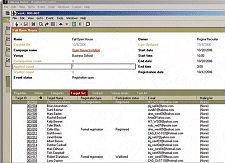Think '360'
- By Rama Ramaswami
- 03/01/07
When it comes to CRM, higher ed institutions are bypassing
traditional offerings in favor of targeted solutions that provide an
up-close, all-encompassing view of student interactions.

KANSAS STATE administrators were
looking to
grab students’ attention with
highly personalized CRM tools.
NO LONGER DO universities have to
decide between off-the-shelf and custom
programs, or between standalone constituent
relationship management (CRM)
applications and ERP-integrated solutions.
Instead, today’s mantra is “360”—an upclose,
360-degree view of student interactions.
Whether the processes and technologies
employed to achieve this are called
constituent interaction management, e-mail
management, content management, or any
combination thereof, administrators are looking
for systems that enable them to monitor
individual interactions throughout a student’s
lifecycle with the institution. And the solutions
universities choose rarely are traditional CRM
programs that work alone or within an enterprise
application; increasingly, colleges and
universities are turning to third-party vendors
to find more nimble programs that are highly
targeted to the needs of a specific institution,
department, or even course offering.
Making It Personal
At Kansas State University, administrators
were looking for a system that would go beyond traditional,
static CRM, and give admissions staffers more versatile
tools to attract students. According to Jan Elsasser,
associate director of admissions and technology at KSU,
because higher ed institutions operate in a “highly competitive
market for students,” schools are looking to grab
students’ attention with personalized technology such as
podcasts, personalized e-mails, and highly targeted content
based on their interests. “A lot of institutions have
customized their ERP systems for this purpose,” Elsasser
says, noting that such customization is not always an
option for every school. “It depends on whether you have
the time and resources [to optimize your existing ERP
system]. If you want to put in the time, modifications can
make it work, but our ERP didn’t come out of the box as
robust as we would have liked.” The CRM component of
the KSU’s existing student management system “really
didn’t meet our needs for recruiting,” says Elsasser. “We
had been processing data on a mainframe that was not
designed around a recruiting system.”
While the cost of a CRM solution varies, the true ROI lies in
the value of the business intelligence administrators receive.
In February 2006, the school implemented Talisma’s Strategic Enrollment Management
(SEM) CRM solution, a highly configurable, internet-based
system that includes e-mail, chat, self-service, and other
channels of contact with constituents. According to Dan
Vetras, president and CEO of Talisma, the program “offers a 360-degree view of historical as well as real-time interactions
with students, and can funnel the data into an existing
back-office environment, whether that be a traditional
CRM or ERP system. Every interaction that has occurred is
visible.” For KSU, this deep insight into interactions has
proven invaluable because it enables highly personalized
service. For instance, Elsasser says, during a marketing
campaign, the system allows administrators to sidestep
generic copy. “Instead, it pushes targeted content to existing
constituents or prospects, based on the information
those individuals have already provided.” She notes that the
system’s highly proactive and flexible chat function is
another benefit. “It can be configured so that if a prospect
is on a web page for longer than, say, 30 seconds, it triggers
a chat event with a live college representative.”
Empowering the Recruitment Office
The University of Alabama, another Talisma customer, is
somewhat further along with its use of the same application,
which the school installed in November 2005 after a
two-year search for a comprehensive constituent management
suite. Says Teri Terry, director of technology support
services in the university’s Office of Enrollment Management,
“We have 400,000 records in our system. We were
looking for a provider that had everything to offer in one
package; whose representatives didn’t tell us, ‘It’s in the
next release.’” Terry found that the Talisma solution offers
myriad channels and opportunities for customer contact,
including phone, e-mail, a portal, web chat, telecounseling,
and, in its most recent release, event registration. It affords
the university insight into all interactions with students, and
“recruiters enjoy it,” she says. “They can see every phone
conversation with the office; every e-mail and every conversation
with the counselor. It empowers the recruiter.”
The cost of the system varies, depending on whether
customers purchase a point solution or the whole suite. But
for Terry, the true return on investment (ROI) lies in the
value of the business intelligence she receives. “We can
track where we’re spending our money, from application
to admission, from suspect [someone who may have
expressed a slight interest in attending the university, but is
not yet a real prospect] to prospect. It’s a huge source of
information that we didn’t have before. For example, if an
event is not yielding enough student enrollment, we can cut
down on the number of times we do it. It enables us to see
what’s successful and what’s not.”
Currently, administrators are in data-gathering mode for
the university’s first full recruitment season using the new
system. “We’re fine-tuning and using more and more of it as
we go along,” Terry says.

TALISMA'S EVENT REGISTRATION feature
allows administrators to closely monitor recruitment
events, to make sure such efforts are yielding enough
student enrollment to make them worthwhile.
The Virtual, Consolidated Contact Center
Investment in advanced technology is solving constituent
management issues for Segar Annamalai, CIO of Alta Colleges
(CO), the parent company of Westwood College,
Westwood College Online, and Redstone College and
Redstone Institute. (Westwood College and its online sister
institution offer two-year, four-year, and specialized programs
in business, industrial design, criminal justice, health
care, and technology; Redstone College and Redstone
Institute are a joint institution offering hands-on vocational
training for the aviation and HVAC/R industries. Altogether,
the colleges comprise 20 campuses across California, Colorado,
Georgia, Illinois, and Texas.)
When the time came to upgrade Alta’s three contact center
locations—which are dedicated to assisting prospective
students with the enrollment process as well as handling
queries from Westwood’s online students—Annamalai
chose to move from a simple PBX system to what he calls
“the latest and greatest technology.” In June 2005, Alta
began deploying a self-hosted version of CosmoCom’s
(www.cosmocom.com) CosmoCall Universe, an enterprise
IP-based unified communications solution that includes
automatic call distribution, interactive voice response, computer
telephony integration, predictive dialing, multimedia recording, interaction history, and administrative tools. Now
students can dial a local or national toll-free phone number,
send e-mail, or visit Alta’s individual college websites, and
CosmoCall Universe seamlessly routes their inquiries to one
of 450 admissions representatives located in any of the
three physical contact centers—effectively creating a new,
consolidated, virtual contact center that improves Alta’s
ability to efficiently and cost-effectively guide prospective
students through the admissions and campus/course selection
processes. And in December 2006, the contact center
was integrated with Alta’s PeopleSoft enterprise system, which the college has adapted for the
higher education environment.
Many CIOs prefer a single-vendor integrated system because
support is easier. Our consensus was that an integrated
system would simplify maintenance. — Bruce Taggart, Lehigh University
According to Annamalai, Alta’s technology selection was
driven by a two-pronged focus: 1) general service quality,
and 2) the system’s ability to meet the unique needs of university
students, who usually have specific questions about
transcripts, grades, exams, course selections, career counseling,
etc., which are not found in any environment other
than a higher ed institution. “Anyone can have the first part,
but the second part is focused on the educational environment.
It’s very, very specific,” notes Annamalai, adding that
while a traditional ERP system does not specifically cater
to the educational environment, CosmoCom’s flexibility
enables student queries to be routed to the agents who can
best answer each question. The software also enables
administrators to measure and monitor the performance of
the school’s enrollment agents, financial services representatives,
and new-student advisers, as well as track a student’s
progress throughout his or her time at the college.
Next-Gen Contact Management
Contact management is the buzzword at Lehigh University
(PA), where Bruce Taggart, vice provost for library and technology
services, was looking to better manage “direct and
indirect relationships based on a contact.” His goal: a more
systematic approach to staying connected; the ability to communicate
with everyone who attends youth camps, alumni
events, and everything in between. “We want to organize the
people who contact us: people who have an interest in the
university, or may have expressed an interest in our lecture
series or research areas,” he says. But, without a contact
management system, “Who knows where that inquiry goes
next? It may never even get checked.”
Taggart believes that the solution to such contact management
challenges is to connect the various databases
across the university (enrollment, admissions, athletics,
performing arts, alumni) with a system that “puts a few
more interfaces among all of them.” This would, for example,
enable the university to send a personalized letter and
performing arts calendar to an alumnus who attended a
research seminar or a soccer or basketball camp. Taggart
explains, “Anytime we make a contact, we need to enter it
into a database so we can respond intelligently.”
With this objective in mind, he chose to beta-test a forthcoming
enrollment management system (scheduled to be
released this year) from SunGard Higher Education. The new system is actually a module that
will fit right into Lehigh’s existing SunGard Banner finance
and student management systems. “Many CIOs prefer a
single-vendor integrated system because support is easier,”
says Taggart. “Our consensus was that an integrated system
would simplify maintenance. These days, a lot of users
don’t want to run separate standalone systems.”
According to Jono Smith, director of marketing for Sun-
Gard HE, the new system is the result of more than two
years of intensive research on enrollment management.
“Our approach is a little of both CRM and ERP, tightly integrated
with student records, portals, and BI tools,” he says,
adding that users can customize the system for their own
needs. (While it is designed for existing SunGard customers,
it is built on a service-oriented architecture so that
it can integrate with other applications.)
“We will have some input into the system’s functionality,”
says Taggart, whose priority is to be able to personalize
communications with constituents. A school can differentiate
itself not only by responding to a constituent’s individual
needs, but also by marketing to those needs. For example,
based on prior purchase patterns, he says, “You can
promote new courses and new merchandise. The system
offers a marketing opportunity for the institution.”
Lehigh’s return on investment is not quantifiable, at least
for now: “Strict ROI? That’s a stretch,” admits Taggart. “But
the return on value is very high. We get 11,000 applications;
we admit 4,000. So we want that edge to be able to
get the best students and faculty.”